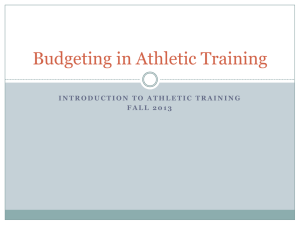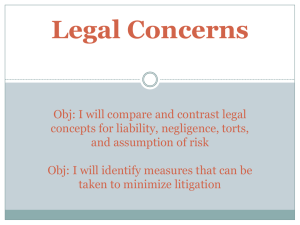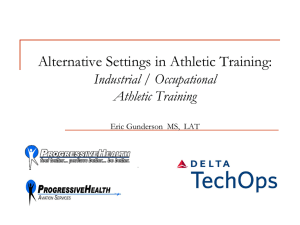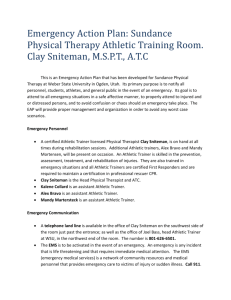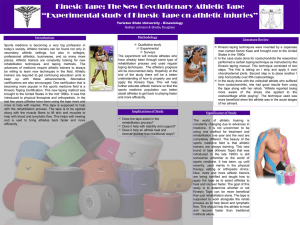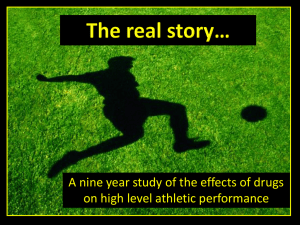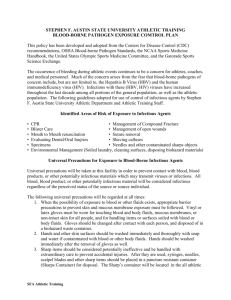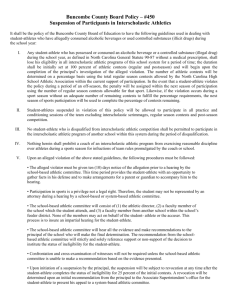Athletic Training
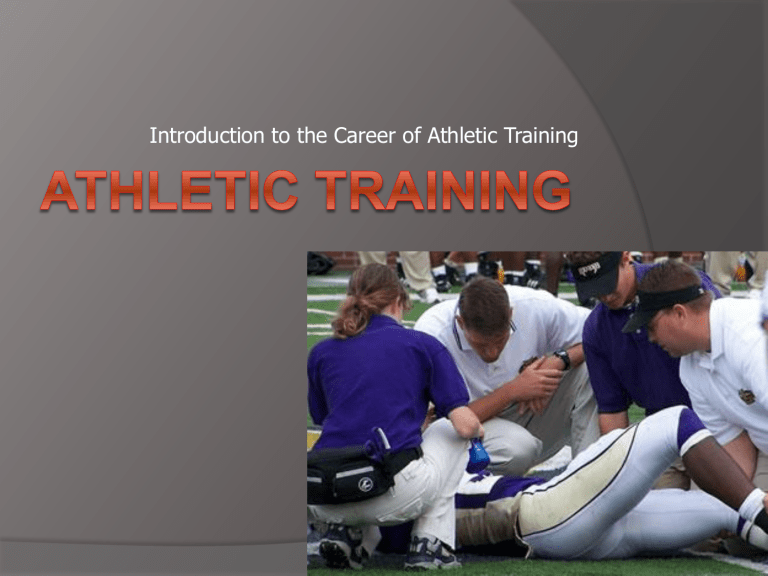
Introduction to the Career of Athletic Training
Athletic Training
Rendering of specialized care to those individuals involved in exercise and athletics.
It is recognized as an allied health career by the American Medical
Association (AMA) in 1991.
Dates as far back as the treatment of gladiators in Rome
Galen was a trainer and physician to the gladiators
Athletic Training cont.
As more people become involved in athletics the field will continue to grow
Certified Athletic Trainers are professionals who have worked to attain certification in the field of athletic training.
Highly educated and skilled professionals who specialize in the prevention, treatment, and rehabilitation of injuries
Athletic Trainers are an integral part of the athletic health care team
Title IX
Federal legislation that prohibits discrimination of the basis of sex as to participation in athletics in schools receiving federal funds
Number of females participating in athletics has increased the demand of
Athletic Trainers
History and Development of
Athletic Training
Cramer Family (1920s)
Gardner, Kansas
Started a chemical company and began producing a liniment to treat ankle sprains
Publication of First Aider in 1932
Family instrumental in early development of the athletic training profession
Continue to play prominent role in education of student athletic trainers
Skills Required
Problem-solving ability
Good Judgment
Good decision-making skills
Proficient knowledge of anatomy, physiology, biology, and advanced first aid
Motor skills
Communication skills
Ability work well with people
Ability to work well under stressful conditions
Ability to maintain poise in emergencies
Education
Bachelor’s Degree in athletic training
The program must be accredited
Classes taken include
Anatomy and physiology
Biomechanics
Exercise physiology
Athletic training
Nutrition
Psychology
Must pass the BOC examination to become certified
Certification
Certification exam is administered through the BOC (Board of Certification)
Three part exam
Written portion
○
Multiple choice
Practical portion
○
Evaluates the skills of the athletic trainer
Simulation
○
Athletic training-related situations designed to approximate real-life decision making
Certification cont.
Six practice domains on exam
Prevention
Recognition, evaluation, and assessment
Immediate care
Treatment, rehabilitation, and reconditioning
Organization and administration
Professional development and responsibility
Once they pass they are able to use the designation ATC
Work Settings
Secondary schools
Colleges and universities
Clinics
Professional sports teams
Industrial settings
Responsibilities
Prevention, recognition, evaluation, treatment, and rehabilitation of athletic injuries
Taping and bandaging
Monitor rehabilitation programs
Use of modalities and training equipment
Recording, organizing , and storing information on injuries and rehabilitation
Compared to other professions, Athletic
Trainers see the whole injury cycle
Hours
Athletic trainers typically work over a 40 hour work week especially in the secondary, collegiate, and professional levels
Most work weeks are 60 to 70 hours Monday through Friday depending on the amount of games during the week
Salary
Days/Week
Hours/Week
Evenings
Athletes/Day
37,500
5
40-60
Yes
>30
High School College
47,000
5+
40-60
Yes
>30
Professional Clinical
60,000
6+
50+
Yes
<45
48,500
5
40
No
<20
Professionalism
There is a national association called the
National Athletic Trainer’s Association along with regional and state associations
Hippocratic Oath
“I will use treatment to help the sick according to my ability and judgment, but I will never use it to injury or wrong them.”
Liable: obligated according to law or equity
Anyone who works outside his or her scope of practice and expertise can be found negligent and liable for his or her actions
Risk Management
Work within scope of practice of knowledge and expertise
Keep proper documentation and maintain accurate records
Follow proper training room rules and procedures
Always have adequate training room supervision
Keep in close contact with coaches, administration, and parents of athletes
Risk Management cont.
Inspect practice and game facilities
Establish a return – to – play protocol
Involve the team physician in all aspects of the program
Establish an advisory program with members of all involved parties
Establish and practice an emergency action plan
Smooth Professional – Athletic
Trainer video
http://www.youtube.com/watch?v=qw3
RHKTkBMk
Roles and Responsibilities of the Athletic
Trainer
3.
4.
5.
6.
1.
2.
Preventative
Recognition, Evaluation, and Immediate
Care
Rehabilitation Course of Action
Administration
Professional Development
Personal Skills
1. Preventative
Pre-Participation Screening (PPE)
Conditioning
Total body
Sport or injury specific
Monitoring Environmental Conditions
Field conditions
Weather
Properly Fitted Equipment
Educate
Parents, coaches, athletes
2. Recognition, Evaluation, and
Immediate Care
Emergency
Acute
Course of Action
3. Rehabilitation Course of
Action
Short Term
Long Term
Return to Play
4. Administration
Documentation
Daily records
Treatment logs
Insurance
Family history
Medications
Surgeries
Written Guidelines
Policy and Procedures
Daily operations
Rules/regulations
EAP
Scheduling
5. Professional Development
Membership in Different Professional
Organizations
Stay current
CEU
Be active in organizations
6. Personal Skills
1. Know the Athlete:
Medical History past/current
Injuries, allergies, meds, contact lens, dental appliances
Personality
Low tolerance vs. high tolerance
2. Know the Sport:
Fundamentals
Demands of sport
Same injury
In one sport not cleared, in another can play
Personal Skills cont.
3. Remain Calm:
Self calm
Calm the athlete
Very difficult to assess if the athlete is scared, excited, and anxious
4. Alert:
Observe all athletes
Limping, down, acting unusual
5. Good Judgment:
Common sense
Personal Skills cont.
6. Experience:
Confidence
Assessment skills
7. Patience (with):
Evaluation
Athlete
Self
Personal Skills cont.
8. Referral:
Record all information
Send to physician
Doubts, concerns
Clearance

